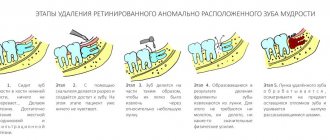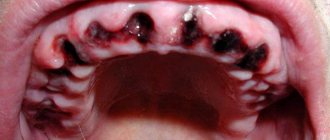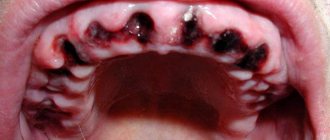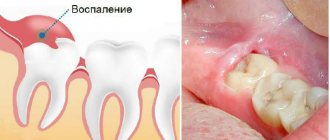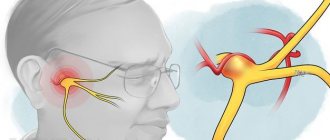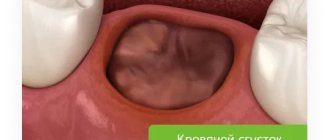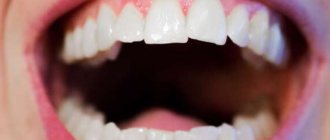Tooth extraction is for some an inevitable and extremely undesirable last resort, for others it is a procedure that is perceived much more favorably than long-term painful treatment. An injection, movement of the surgeon’s hand with the instrument - and the pain disappeared. But with the removal of the source of infection, the rotting, decaying dental skeleton that brings pain and suffering, relief lasts only as long as the anesthetic injection is in effect. When the gums move away from the frost and its insensitive numbness stops, it begins to hurt.
Pain after tooth extraction: how many days does it last?
Why is tooth extraction required?
In certain cases, tooth extraction is the only possible method of solving a particular dental problem. Indications for removal may include:
- Incorrect position of the tooth, when neither the patient nor the doctor can access it (high-quality hygiene and/or treatment is impossible);
- The absence of the main part of the dental material without a chance of its restoration;
- Malocclusions (for example, severe crowding);
- Inflammatory process in the roots of the tooth, which can lead to infection;
- Painful eruption of wisdom teeth.
This is also necessary when preparing to correct your bite using Invisalign aligners. In particular, it is usually necessary to remove the “eights” if they have not fully erupted and can interfere with quality orthodontic treatment. It is worth noting that such a decision should be prepared when there are certain indications and no other option is possible.
Otherwise, when installing aligners, the unerupted tooth hidden inside the gum will prevent the aligner from attaching and pull the remaining teeth in the right direction, leaving them no room to move.
How to remove a tooth
There are two extraction methods used in dentistry: simple and complex. Their choice depends on which teeth are being removed - premolars and molars with tangled branched roots are removed using a complex method. It is very difficult to pull out such elements entirely due to the fact that the tooth socket is penetrated by retaining ligaments and alveolar processes. Errors during the procedure or insufficient experience of the specialist lead to serious complications. Therefore, even despite the acute condition, always find out in advance where you can have a tooth removed from a good doctor with positive recommendations.
Factors complicating the operation:
- complete destruction of the coronal part;
- high fragility;
- acute inflammatory diseases;
- Unerupted or misaligned wisdom teeth.
The technology of the procedure depends on which teeth are removed. In some cases, tissue incision and suturing are performed.
Whether it is painful to remove a tooth or not depends largely on the condition of the element. Anesthesia is performed in all cases, with the exception of severe allergic reactions to all types of painkillers. With the development of extensive purulent lesions, the effect of the drug may be reduced.
How long it takes to remove a tooth depends on the complexity of the operation. On average, this takes no more than 5-10 minutes (including waiting for the anesthesia to take effect). In general, the procedure includes the following steps:
- anesthesia;
- if necessary, an incision is made into the mucous membrane to access the cervical area, or the doctor lowers the gum with an instrument;
- Use forceps to fix the tooth at the lowest point without excessive pressure;
- rocking and extraction from the hole is performed;
- returning the gum flap to its place.
If inflammatory processes are diagnosed in the oral cavity, a course of antibiotics is prescribed. In some cases, extraction is performed under general anesthesia.
In case of multiple lesions, the doctor determines how many teeth can be removed in your case during one visit, but more often it is 1–2 elements. This is because extraction is a traumatic operation that will take time to recover from. Too large areas of damage increase the likelihood of complications several times and take much longer to heal.
If after surgery the extracted tooth, or rather the hole left after it, hurts, this is a reason to consult a doctor. After the procedure, minor pain is allowed during the first 24 hours. Visit the dentist if your temperature rises, swelling increases, bleeding occurs, or pain spreads to the lymph nodes. These are symptoms of a wound infection. Untimely treatment can lead to alveolitis.
Why does a pulled out tooth hurt?
The presence of pain after tooth extraction is due to the fact that soft tissues, blood vessels and nerves are damaged during tooth extraction. Typically, the first pain symptoms appear 3-4 hours after surgery. This is due to the fact that this is when the anesthesia stops working.
Also, during removal, the bone tissue of the jaw socket may be damaged. In this case, the pain during the healing period is more intense and prolonged. However, if the removal was carried out correctly, it will soon pass.
How long does it hurt?
In most cases, pain during removal worsens on the second day. On the third day they begin to decrease. By the fourth or fifth day, there is practically no pain. If by this period the pain after tooth extraction does not subside, the patient should consult a doctor, as this may indicate the emergence of complications.
However, it is important to remember that complete healing of the hole occurs only in the second or third week after the procedure. Until this time, the gums and bone tissue are vulnerable, so if they are irritated, pain may also occur. To prevent this from happening, you should follow your doctor's recommendations.
Headache
The recovery period after tooth extraction may be accompanied by headaches of varying intensity. They are associated with damage to the nerve fibers that go to the brain. Such symptoms should not frighten the patient, since as the wound heals, they will also pass.
Another cause of headaches during this period may be hypertension. The patient must notify the attending physician about the presence of such an illness. In this case, the surgeon will be able to select appropriate medications that will reduce pain.
Ear pain
For the same reasons, a patient may experience unpleasant or even painful sensations in the ear after tooth extraction. Most often they have a shooting character. This symptom is also normal and goes away in the coming days after the intervention.
Ear pain may worsen if, after the procedure, the patient does not properly care for the oral cavity and tries to chew solid food.
Pain in the gums
Pain in the gum is associated with its direct damage. In this case, not only the soft tissue suffers, but also the nerves, which are also located in the gums. Depending on the degree of damage, pain can last for different times and occur with greater or less intensity.
Increased pain in the gum may indicate the presence of fragments in its tissues, as well as the occurrence of one or another complication. If such symptoms occur, you should immediately consult a specialist.
Hematoma
In addition to alveolitis, another complication such as hematoma and suppuration of the hematoma occurs. At the same time, we see normal healing of the socket, but there is pronounced swelling and pain in the soft tissues (cheeks, along the transitional fold).
The main signs of a hematoma are:
- swelling of the cheek in the area of the extracted tooth or at the site of anesthesia;
- pain when touching the cheek;
- the cheek is warmer than the surrounding tissues;
- cyanosis appears on days 3-4;
- the temperature may rise.
There can be many reasons for the formation of hematomas, but the main ones are:
- vascular injury during anesthesia or removal of tooth fragments. All people have different vessels, and the surgeon cannot say with certainty where the vessel will go;
- problems with blood clotting (diabetes, leukemia).
Hematomas also cannot be treated at home. You definitely need to see a surgeon.
If the hematoma is relatively small and there are no signs of suppuration, then drugs are prescribed to resolve the blood. If the hematoma is large and there are signs of suppuration (fever, sharp pain, redness of the cheek and increased skin temperature, tissue tension), then an incision is made along the transitional fold, pus and excess blood are released, and drainage is placed in the wound. After a week, the wound heals, leaving a scar.
Home treatment of hematomas is fraught with the formation of abscesses and phlegmons, which may require external incisions and subsequent cosmetic surgeries, and in advanced cases can cause serious complications for the body as a whole.
Will the site of the extracted tooth stop hurting on the second day?
Patients often believe that the pain at the site of pulled out teeth should go away after sleeping on the second day, and they get scared when it becomes even stronger. This situation is normal, since after a certain time the damaged gum tissue begins to swell, thereby pinching the nerves. All this leads to pain becoming more intense.
You need to be prepared for this. Today there are a large number of analgesics and other medications that can reduce inflammation and eliminate pain syndromes.
How long does pain last normally?
When describing unpleasant sensations, clinic patients usually point to their aching nature. How long the discomfort lasts is determined by:
- where exactly the extracted tooth was located;
- how carefully the work was carried out;
- whether the patient carefully followed the doctor’s instructions received after the operation;
- what condition were the tissues and mucous membranes in before the start of dental therapy.
As practice shows, the hole normally bothers you for about two to four days. Every day the affected area becomes less and less sensitive. If after five days the discomfort does not subside, you should definitely consult a dental surgeon.
The site of tooth extraction hurts after a week, what should I do?
The holes in which the extracted teeth were located are usually completely healed by the end of the first week. Final healing still needs to wait, but the pain should have passed during this period. If, after a week, the area continues to hurt after tooth extraction or any other symptoms appear, such as bleeding, the patient urgently needs to see a doctor.
Under no circumstances should you try to relieve pain on your own. If it continues to bother the patient, this may indicate the development of inflammation or an abscess process in the gum. If they are not eliminated in time, the consequences can be very serious.
How to treat gums at home
The basic rule of home therapy is to follow all medical prescriptions. If there is a special anti-inflammatory medicine in the inflamed area, you should not remove it without permission due to the unpleasant taste or odor. The doctor will do this himself or will tell you exactly the day and time when it is necessary to remove the medicated compress.
Dentists often prescribe soda baths. To carry them out, you need to mix a teaspoon of baking soda with a glass of warm water. Keep the solution in your mouth without rinsing. This simple measure helps to quickly remove the purulent exudate.
It is very important to follow a gentle diet during the recovery period. If there is severe pain on the first day after surgery, it is permissible to take a painkiller. If the medicine does not help or reduces the uncomfortable symptoms only slightly, you should definitely seek qualified help.
A good healing effect is provided by antibacterial gels and ointments designed specifically for treating gums. They must be prescribed by a dental surgeon.
If the operation was difficult and the likelihood of postoperative complications is high, the doctor may prescribe oral antibiotics. Typically, dentists prefer broad-spectrum drugs. It is permissible to use them strictly according to the scheme selected by a specialist.
Stages of socket healing
The holes in the place of pulled out teeth heal in several stages. The first one lasts about a week. At this time, the wound heals, its surface becomes smoother. The patient can return to his usual lifestyle - eat regular food, brush his teeth, etc. Usually, during this period, a blood clot remains on the surface of the hole, which in no case should be torn off, as this can lead to bleeding and will slow down the final healing process.
Complete healing of the wound ends by the end of the second week. At this time, the clot disappears, and residual pain goes away. The last stage, that is, complete healing, ends by the end of the third week. If the intervention was very serious, this period may last 4 weeks. By this time, the nerve fibers and blood vessels are completely restored, and the gums become completely smooth.
What happens if you ignore pathological pain
The appearance of pain always signals a problem in the body. If the tooth was removed long ago, and the pain persists or increases, this is evidence of a complication. Pain may be associated with:
- Increased body temperature;
- severe swelling, redness of the mucous membrane;
- halitosis;
- purulent discharge from the socket;
- white or gray coating on the mucous membrane;
- enlargement of the submandibular lymph nodes;
- pain while swallowing;
- restriction when opening the mouth.
In this situation, you should see a doctor immediately.
Ignoring alarming symptoms is fraught with serious problems, such as abscess and osteomyelitis. These are serious pathologies that require timely, qualified treatment.
Complications after removal
In some cases, tooth extraction can cause complications. They can be associated both with poor quality of the procedure itself and with illiterate oral care during the healing period.
The main complications that may arise during tooth extraction include the following:
- an abscess that appears as a result of infection in open wounds in the sockets where teeth used to be;
- bleeding, which may be a consequence of injury to the gums during the healing period, and may also occur due to the presence of hypertension or poor blood clotting in the patient;
- paresthesia, characterized by numbness of the gums or part of the jaw in the place where the tooth was pulled out.
One of the most serious complications is osteomyelitis. It is characterized by the presence of an inflammatory process in the bone and bone marrow. This disease can occur when the patient has an infection of the bone tissue against the background of a general decrease in immunity. This disease requires immediate treatment.
Symptoms
The main symptom of a complication after tooth extraction is increased pain after the 5th day of healing. If by this period they do not subside, then you need to contact a specialist to find out the reasons. This could be either inflammatory processes or the presence of tooth particles that went unnoticed after the procedure.
Another symptom is a strong increase in temperature, sharp cramps in the head that last more than 5 days. This can also cause your gums to swell. If this happens, it means that the swelling cannot go away for some reason. This, in turn, is a sure sign of a complication.
Reasons for the development of complications
There can be a large number of reasons for the appearance of one or another complication. In addition to medical errors and improper oral care, these include the presence of certain physical diseases in the patient, which can lead to the development of inflammation or frequent bleeding.
To prevent such situations from arising, the patient must warn the doctor about all his ailments, even if he is sure that they will not affect the outcome of the procedure. After this, the specialist will be able to select certain medications that will reduce the risk of complications and make the wound healing process more comfortable.
Treatment at the dentist
The doctor begins treatment by washing the socket and treating it with antiseptic solutions, and then cleans the socket from the remains of the blood clot using a surgical curette. Then the wound is dried with a gauze swab and treated with an anesthetic and antibacterial agents. The wound is covered with a bandage, which is designed to protect the open surface of the wound from possible biological, chemical or mechanical irritants. To check the possibility of detecting pieces of the extracted tooth in the socket, an x-ray can first be taken.
The procedure for cleaning the hole as a whole is carried out according to the following scheme:
- Local anesthesia is performed;
- The well is washed with an antiseptic solution (hydrogen peroxide solution 3%, chlorhexidine 0.05% or furatsilin 0.02%), and food debris and necrotic masses are removed;
- If there are foreign bodies in the hole (root fragments, cysts and granulomas), they are removed using special instruments;
- After cleaning the hole, it is treated with antiseptic solutions, dried with a sterile gauze swab, and turunda with an antiseptic and an anesthetic is injected into it. With a mild degree of inflammation, a turunda may not be necessary; thorough cleansing of the hole and subsequent care for it is sufficient;
- In case of a pronounced necrotic process in the hole, rinsing and application with trypsin is carried out - this is an enzyme preparation that accelerates the breakdown of dead tissue. Trypsin has anti-inflammatory and anti-edematous effects, helps clean the socket from necrotic masses and pus;
- After completing all the manipulations, the patient goes home, the doctor appoints appointment days when he needs to come for antiseptic treatment of the hole and change the turunda, if one has been installed. If necessary, a course of antibiotics is prescribed.
For alveolitis, antiseptic baths (not rinsing) with solutions of chlorhexidine 0.05% or miramistin 0.01%, which can be purchased ready-made at the pharmacy, are effective. When performing baths, the solution is taken into the mouth and held for several minutes, then carefully spat out. To relieve pain and reduce the degree of inflammation, nimesulide or ibuprofen are prescribed.
To prevent the turunda from falling out of the socket, during treatment you need to eat soft, pureed food and do not chew on the sore side. If the turunda does fall out, you need to rinse your mouth with chlorhexidine solution and immediately consult a doctor.
If this is not possible, you should rinse the hole yourself from food debris: to do this, bite off the sharp tip of the needle from a 5 ml syringe, bend it a little, and disinfect it with pure alcohol. A chlorhexidine solution is drawn into the syringe, the needle is inserted into the hole (not too deep) and the piston is pressed intensely to create a liquid pressure that can remove food debris.
All cases of alveolitis treatment are individual, so it may be necessary to visit the dentist up to several times.
With a favorable course of the healing process, the pain goes away, and the inflammatory process gradually subsides and disappears after a few days.
If the process, despite the procedures performed, progresses, then after antiseptics, gauze tampons soaked in propolis tincture or camvorophenol solution (10%) are inserted into the hole. A tetracycline-prednisolone cone inserted into the well has a good antibacterial effect.
What to do after removal?
After tooth extraction, it is important to maintain proper oral hygiene and also slightly limit your diet. The main recommendations are:
- You can apply a cold compress to the damaged gum, which will reduce the pain;
- if the bleeding does not decrease, you can firmly press a cotton swab between the teeth in the area of tooth extraction;
- For disinfection, rinses based on natural herbs should be used;
- It is better to eat only warm and soft foods without solid particles.
Medications can also be used to reduce discomfort. However, you can only use those medications prescribed by your doctor. He should also tell you how long to rinse so as not to damage the wound.
If at any stage of healing the patient feels an increase in pain symptoms or discomfort that is not normal, he should immediately inform the doctor.
Doctors providing this service
December 6, 2018
Of all the teeth in the mouth, wisdom teeth are the ones that most often have to be removed.
Of all the teeth in the mouth, wisdom teeth are the ones that most often have to be removed. There are a number of important reasons for this:
- the remote location of wisdom teeth makes their hygiene difficult, ultimately contributing to the fairly rapid destruction of the enamel;
- often wisdom teeth do not have enough space in the jawbone, and they erupt unevenly, “into the cheek,” or rest against neighboring teeth, contributing to their destruction;
- if one of the wisdom teeth has been removed, its antagonist begins to move towards the missing one, deforming the dentition;
- inflamed tissue and pain in the gum near the wisdom tooth.





